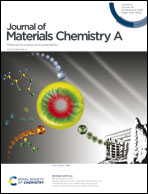An ultrathin, strong, flexible composite solid electrolyte for high-voltage lithium metal batteries†
Abstract
The urgent need for safe, energy-dense electrochemical storage devices calls for high-voltage solid-state lithium metal batteries. However, state-of-the-art solid-state electrolytes are hindered by two critical issues: the narrow electrochemical window, which prevents the pairing of a lithium metal anode with a high-voltage cathode, and the large thickness which leads to a huge internal resistance and a significant sacrifice in energy density. To simultaneously address both the issues, in this work we develop a poly(acrylonitrile) (PAN)–LiClO4–boron nitrite nanoflake (BNNF) composite electrolyte modified with a BNNF layer (PBCEB). The PAN–LiClO4–BNNF composite can sustain an oxidation voltage of up to 4.5 V vs. Li/Li+ while the BNNF modifying layer prevents the PAN–LiClO4–BNNF from the reduction reaction with the lithium metal anode. In the meantime, thanks to the BNNFs, the PAN–LiClO4–BNNF possesses a strong tensile strength (16.0 MPa) and Young's modulus (563.7 MPa), which enables the PBCEB to be as thin as 13.5 μm (12.0 μm for the PAN–LiClO4–BNNF and 1.5 μm for the BNNF modifying layer). As a result, a Li/PBCEB/LiNi0.8Co0.1Mn0.1O2 full battery delivers a high specific capacity of 173.6 mA h g−1 at 0.2C and achieves a remarkable capacity retention of 68.1% after 350 cycles at 1C. This work provides an effective approach to develop high-performance composite solid electrolytes for high-voltage lithium metal batteries.



 Please wait while we load your content...
Please wait while we load your content...